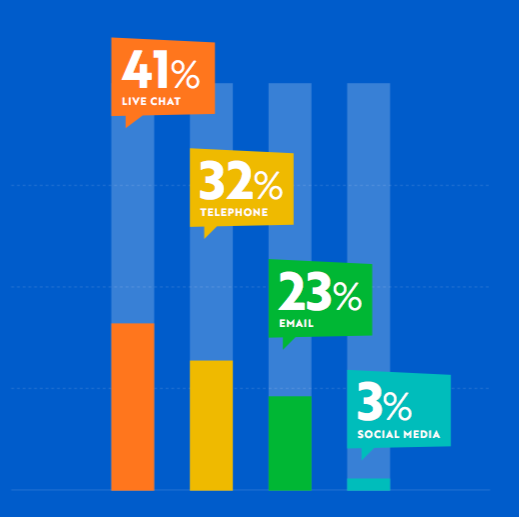You might believe social media is a boon for customer care. It’s understandable. A Google search for the phrase ‘social media customer service’ returns 117 million results.
It’s easy to find authoritative articles, like this one, that claim customers love to use social media for customer support—and they have statistics to back it up.
And yet, our investigation tells a different story:
Only 3% of consumers picked social media as their go-to channel over live chat, phone, and email. Whereas 41% picked live chat, in a recent live chat statistics survey we conducted.
Why is conventional wisdom so confused about social media’s place in customer support?
Why are we told social media is a customer support magic bullet?
1. The hype machine
Those who are best at social media are also the loudest and write the most about it. It’s the nature of the beast for a pro-social-media viewpoint.
2. Outdated statistics
When a modern messaging app wasn’t an option for customer support, social media was a favorite for many consumers. For example, in 2012 Nielsen reported that a third of consumers prefer social media when compared with the phone. That number will have increased by now. However, when live chat is presented as an option, preference for social media drops.

Why? Most likely because live chat does everything for customer support that social media does, but better. The same people who prefer social media over phone or email will leap to live chat, as will a handful of those who would previously chose the phone or email.
Social media could tear you apart, or give you great press
Place yourself in a small town 100 years ago. Horse and carts trundle down the streets. Maybe one or two hot-shots are cruising around in a Ford Model T (the showoffs).
Imagine owning one of three bakeries in town. You recognize almost all your customers on sight. You greet them with a smile, and cheerfully chat with them as they go about their buying routine.
One day, three people come in who aren’t regulars. You ask what brings them in. They say their usual baker (who’s a bit of a grump) sold one of them a slightly stale loaf. He then refused to refund her, and she decided to take her custom elsewhere. Her friends, of course, followed suit.
It doesn’t stop there. Throughout the week you see more new faces walk in. As the story spreads along the grapevine of small town gossip, other people recalled underwhelming loaves that they bought from the grumpy baker without bothering to complain. The story of his disregard for a loyal customer convinces them to try this other, more agreeable baker who they are now hearing about.
In small towns, customer service has always been critical.
Throughout the 20th century industrialization and urbanization swept the globe. A complaint shared amongst friends at a book club now had almost no effect on the profits of the majority of businesses we dealt with. Since it was no longer profitable, customer service slipped. Frustrating automated phone trees were installed, and human contact became a premium.
When social media entered the scene, there was one purpose we were desperate to use it for – complaints.
Suddenly, a complaint could reach everyone. A poor product that’s not refunded or dealt with can be ranted about on Twitter or Facebook and be reshared until hundreds of thousands of eyeballs have seen it.
The problem is made worse by the fact that people tend to talk about bad experiences more than good ones. According to Marketing Charts, consumers who suffer a bad interaction are 50% more likely to share it on social media than those who had good experiences.
The grapevine of gossip is back, this time on a global scale. Social media is the perfect vehicle to publicly complain, and gain attention to problems quickly.
How do you stop a complaint from ever reaching the world stage? Address the issue before it ever leaves your walls.
The live chat advantage
Massive advantages come with digital technology, (such as automation). Only problem is, they come lumped with parallel disadvantages. Imagine a store where there are no humans to speak to. If you have an issue you have little option other than to leave the store and complain about it to your friends.
What would change if you planted staff members around your store, available to chat to at a moment’s notice? Now you have something closer to the Apple store, which provides such a pleasant experience that people are known to go there just for fun. That is the live chat advantage.
With live chat you’re able to catch issues before they leave your “walls” (webpages), and you’re significantly reducing the chances of having a social media customer service PR crisis.
Beyond complaints: The customer relationship
Timely is a SaaS company that I feel like I have a relationship with. While their software is a cool time-tracker, it’s the company that I feel attached to because Timely is a company that listens.
Within their app you’ll find a little live chat button in the lower right hand corner. Crucially, when you shoot off a question, I’m not left hanging, someone responds.
I pay for their premium service even though I don’t strictly need the fancier features. What’s going on, psychologically, to compel me to do that?
My loyalty comes from being listened to.
Whenever a bug showed itself in the software, I would tell them via live chat, and they would respond with gratitude and an assurance that it would be fixed soon—and it often was! I started to feel like I helped with the development of this software, like there was a part of me in it.
In truth, I’m just like 73% of other people who say a business that values a customer’s time is the most important thing they can do to provide them with good service. If I take the time to tell a company about something, the least I expect is that I’m heard and my input is valued.
Each month I pay my subscription to Timely, and that bottom line revenue is directly connected to their responsiveness. They can drop the ball and ignore a few messages from me without losing me. But if that continues for too long, however, I may start reconsidering my paid subscription.
Time invested in building relationships with your customers pays real dividends.
What keeps people coming back to live chat?
The two keys to live chat’s superiority in customer care is its privacy and ease. No matter what system you use, keep these two factors in mind:
1. More privacy
“For every customer who complains, 26 others don’t speak up.” Source: White House Office of Consumer Affairs.
Most customers who encounter problems, will keep it to themselves unless there’s an easy way to talk directly with your staff.
If you have an easy live chat system installed and responsive reps behind it, you give your customers and prospects a way to voice their concerns and problems in a safe place. As long as they feel listened to, the vast majority will want to keep the conversation private, rather than take to the public stage of social media.
2. Reduced effort
The Harvard Business Review claimed the #1 most important factor in customer loyalty is the reduction of customer effort.
Sprint, for example, saw an increase of 31% in private messages 3 months after launching Facebook Messenger for customer care. Clearly, it was better than nothing, but why try to wrestle another platform into a live chat substitute?
The problem is they forgot about the cognitive effort required to switch platforms to begin a transaction. If they’re experiencing an issue on site and there’s no live chat, they have to navigate to a new site, find the correct Twitter handle and fit their complaint into 240 characters.
Having live chat available to begin a conversation significantly reduces customer effort as soon as a customer runs into an issue.
Modern live chat tools are built to be as low-friction as possible.
Give your customers a modern messaging experience on your website. This way you reduce the effort needed for your customer to search for the most interactive channel. You don’t need to switch platforms, or search for a company’s profile in order to send a simple message.
Instead, the chat box is a single click away, and it never leaves the website itself. This may not sound like a big difference in effort, but it’s certainly enough for someone with a simple question to think, “Ah, screw it.” and hop right onto your competitor’s site.
Looking for modern live chat messaging for your support team? Try Kayako Messenger on a 14 day free trial or check out our pricing.

